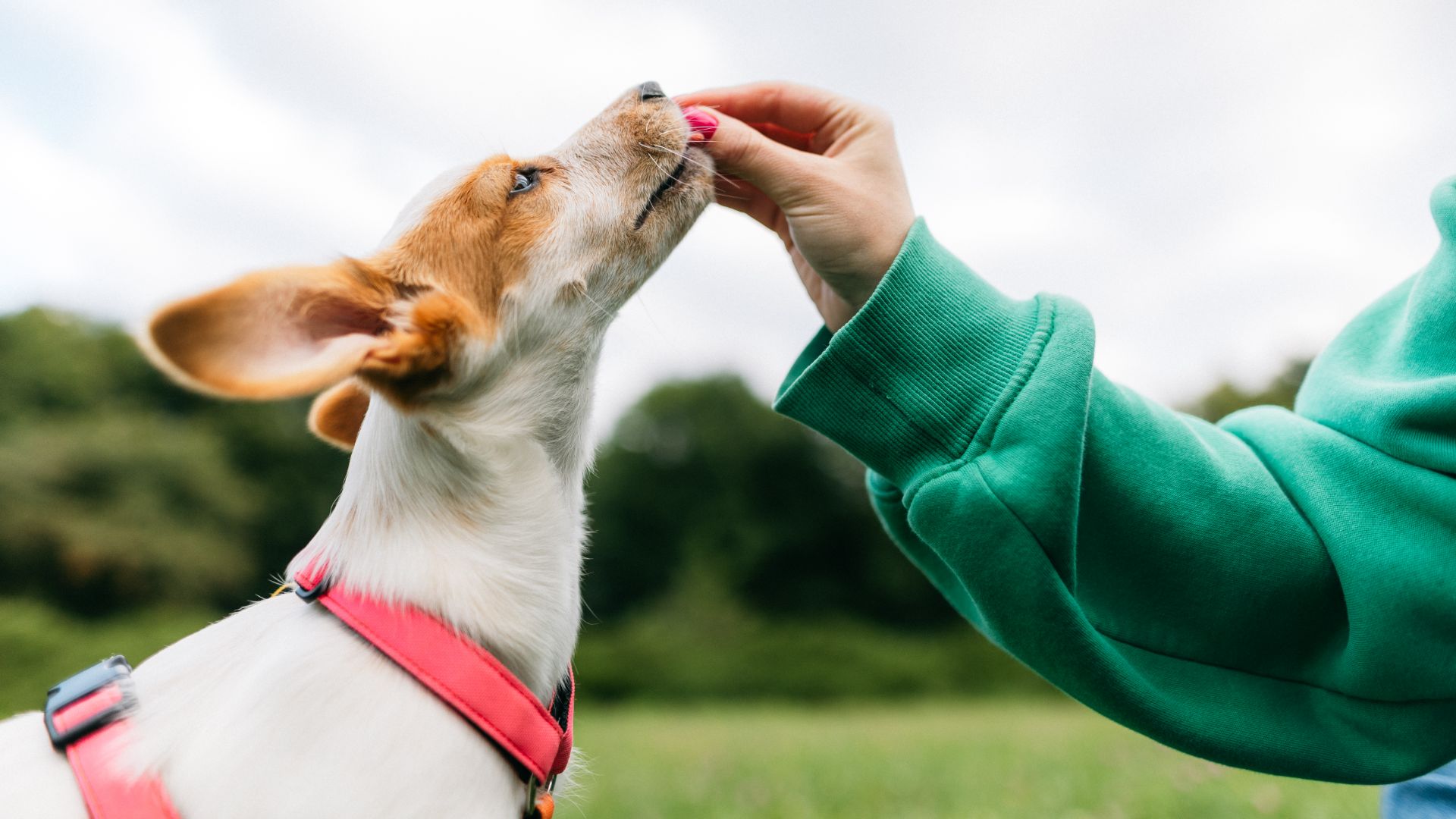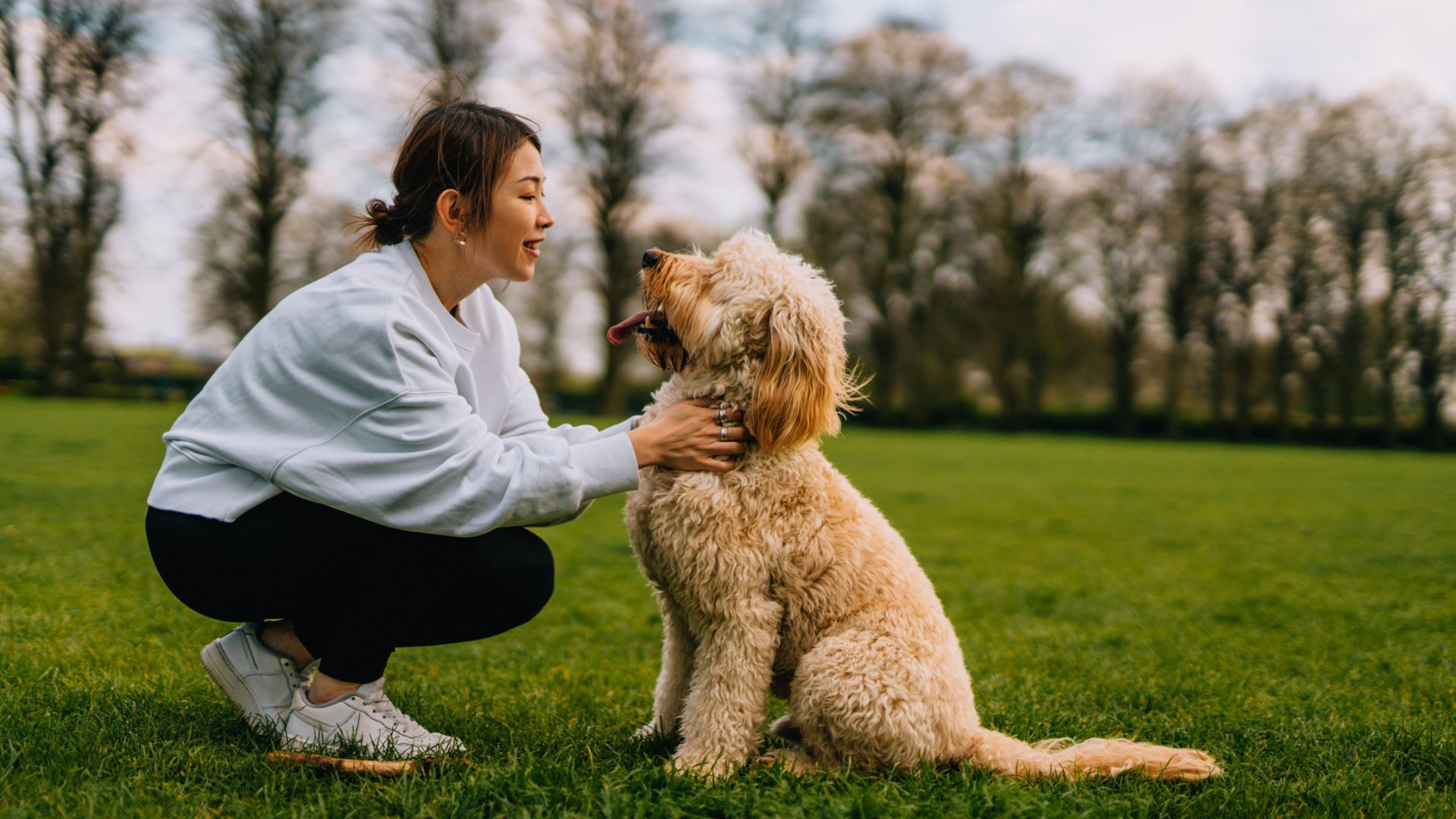The science behind positive reinforcement for dogs
You may have heard that positive reinforcement is the best way to train a dog, but do you know why?

You might have heard of positive reinforcement for dogs in training, but do you know what it actually means? This widely-used method of dog training is based on science and isn’t just a fad. It involves rewarding your pet in return for the ‘correct’ behavior.
This should encourage your dog to repeat the behavior in the future, knowing that he will get something good out of it. The reward can be food-based in the form of the best dog treats, play-based using the best dog toys, or praise-based with lots of attention and a good fussing.
We’ve known how animals change their behavior if they know they're going to get something they want since the early 1900s, but it has taken a long time for positive, reward-based training to become widespread. Even now, dominance-based and fear-based trainers are still all-too-common, despite names such as the Association of Professional Dog Trainers recommending against it. So, just why is positive reinforcement so effective, and is it really better than dominance methods and ‘e-collars’?
What is positive reinforcement for dogs in training?
‘Positive reinforcement’ was a term first put forward by BF Skinner in the mid-20th Century, but it can also be called reward-based training. It has been a theory since 1910 when it was first discovered that animals will repeat a behavior if it gets them a reward.
Our evolution, and that of domesticated dogs, has occurred because of rewards. The first human hunter-gatherer to purposefully bury his food in the hope of a crop took a risk and, presumably, was rewarded for it. He then repeated the experiment and, again, was rewarded, ‘reinforcing’ the behavior.
Similarly, wild dogs will have bravely approached human dwellings and been rewarded with food scraps. Their behavior was rewarded time and time again, reinforcing it and eventually leading to domestication.
When we’re training dogs, ‘positive reinforcement’ involves training with treats and giving a reward when the correct behavior is shown. Dogs are encouraged to show the behavior by tricking them (such as with a ‘sit’ command), ‘capturing’ a natural behavior (such as with a ‘paw’ or ‘shake’ command) or building on a previously learned behavior. As soon as the behavior is shown, a reward is given. The animal will then be more likely to repeat the behavior to see if it can get another reward.
Get the best advice, tips and top tech for your beloved Pets
Positive reinforcement for dogs is effective when done with consistency and patience. It helps to build your dog’s confidence and allows them to know what is expected. Animals that are punished are often nervous and fearful and show more behavioral problems.
Positive reinforcement actually works with any species of animal. You can even teach a pigeon to spin in a circle on command, given plenty of time and enough valuable rewards!
Why is reward-based training better for dogs?

A change in animal behavior can be put down to two things – either they learn to do something because they were rewarded for doing so (a positive consequence) or they learn to do something because not doing it results in something unpleasant (a negative consequence).
Unfortunately, some dog training techniques focus on the unpleasant consequence – they use fear (aggression, noise) or pain (shock or prong collars) to force the dog to do what the trainer wants them to do.
There is good evidence that aversive training methods, such as punishment, are bad for a dog's physical health, mental health, and long-term welfare. Even when these methods aren’t directly damaging the dog, there is no evidence that they’re any better than positive reinforcement for dogs – and may in fact be worse.
In fact, we now know that negative training methods create fear, which can inhibit learning and mean that they’re actually less effective than the positive methods. This recent review compared 17 studies on this subject and determined that handlers should use positive reinforcement and avoid methods that require punishment or negative reinforcement.
Stella & Chewy's Stella's Super Beef Dinner Patties Freeze-Dried Raw Dog Food | Chewy
If your dog follows a raw food diet, they'll love these tasty and nutritious freeze-dried patties. Made with grass-fed beef raised without hormones or antibiotics and 100% organic-certified fruits and vegetables they contain probiotics to aid in healthy digestion.
What are the problems with reward-based training?
The biggest problem with positive reinforcement for dogs is that it requires empathy and patience from the person doing the training. Unless the dog (or cat, or horse, or any animal) shows the behavior, they should not be rewarded.
This means it can take some time for the correct behavior to be shown (patience), and when the dog isn’t showing the behavior, the trainer needs to take a step back and try to work out why (empathy).
Some trainers will tell you that the dog isn’t showing the behavior because they are disobedient or even because they are trying to dominate you. However, dominance theory is outdated and has been shown to be based on poor science and sweeping generalizations.
Any dog can be taught using positive, force-free training techniques, but it takes time. Working out why the dog isn’t offering the behavior can be difficult, and positive trainers may have to gradually unpick anxious, stressed dogs – especially if aversive, negative, training methods have previously been used.
Can you train a dog with only positive reinforcement?
Yes. In fact, you should only ever train a dog with positive reinforcement. As discussed, punishment techniques are counterproductive and are likely to do more harm than good. If you focus on giving your dog lots of fuss, praise, and treats for good behavior, then they will want to do this time and time again.
The key is to work out what motivates your dog the most, whether that is high-value treats (small pieces of chicken, cheese or dried meat treats often work well), throwing a ball for him, or giving him lots of verbal praise.
Does positive reinforcement work for aggressive dogs?
Positive reinforcement should work in aggressive dogs, but it can take time and patience. There are no quick fixes when it comes to dog training, and you should work closely with a qualified dog trainer if you have a pet with aggressive tendencies.
It may also be worth speaking with your vet too, as some dogs may be showing signs of aggression due to underlying health problems or pain. They may also be able to suggest treatment options, such as calming supplements or even prescription behavioral medications, to help make handling and training easier.
There are some cases where the dog has shown such levels of aggression that euthanasia is the safest option, particularly in families where young children are present. Speak to your vet if you are contemplating this, as they can help counsel you through it.

What sort of rewards should I use for dog training?
Of course, this means you’re going to need to find some great rewards so you can celebrate your dog doing the right thing. Whilst food has always been a good choice, some dogs are more driven by play or a life reward, such as the opportunity to sniff or chase. The important thing is to work out what your dog really loves and is most motivated by. You’ll probably find that this changes over time, so you might want to have a variety of rewards for positive reinforcement training.
You might find that some people suggest that your dog doesn’t need a reward after each behavior. In fact, some people theorize that intermittent rewarding is actually better than rewarding every time – keeping your dog ‘guessing’ increases their motivation and makes them try harder to learn.
However, recent research shows that not giving rewards every time the behavior is displayed results in a ‘pessimistic viewpoint’, which is thought to be bad for your dog’s mental health. Another study also found that dogs given rewards only intermittently learned more slowly than those given a reward every single time.
We also know that the timing of the reward is important – it needs to be given exactly when the behavior is being shown. Giving it later, even a couple of seconds later, doesn’t work. This can be difficult, especially when the behavior is short-lived.
Some trainers advocate the use of a ‘clicker’ (a plastic device that makes a clicking sound when pressed) to ‘mark’ the behavior. The clicker’s purpose is not to replace the reward, but it helps your dog make the connection between the behavior and the reward.
Greenies Variety Pack Regular Dental Dog Treats, 36 count | Chewy
Keep your dog's teeth and gums in tip-top condition and their breath super fresh with these dental treats that are easy to digest and taste delicious — or so our pups tell us!
Conclusion
Dogs by their nature are eager to please and positive training can help you to bond with your dog and foster a good working relationship. Plus, you will have more fun with your pet knowing they are happy and being rewarded for their efforts during the training process – and beyond.
If you’re struggling with dog training, find a dog trainer that uses positive methods to help you. Not sure if a trainer is right for you? Get to know how to spot dog trainer red flags as part of your research.
Still not convinced? Here are 32 reasons to avoid using punishment with your pet
After graduating as a vet from the University of Nottingham in 2016, Dr. Joanna Woodnutt went on to practice companion animal medicine in the Midlands. She quickly developed a love of consulting and helping clients with medical problems such as dermatology, behavior and nutrition - anything that involved helping clients understand their pets better.
Jo started writing about pet health in 2017, realizing that it meant she could help even more pet parents. Since then, she has written for countless online and print publications and is a regular contributor for Edition Dog Magazine. Jo is the director of The Veterinary Content Company, which she founded in 2020. She is also the founder of Petlearnia, a platform that provides pet e-learning courses for pet parents.
Jo now lives in the Channel Islands with her husband Ian and terrier Pixie.
- Bethany StoneFreelance Writer
- Dr. Rebecca MacMillanVet



